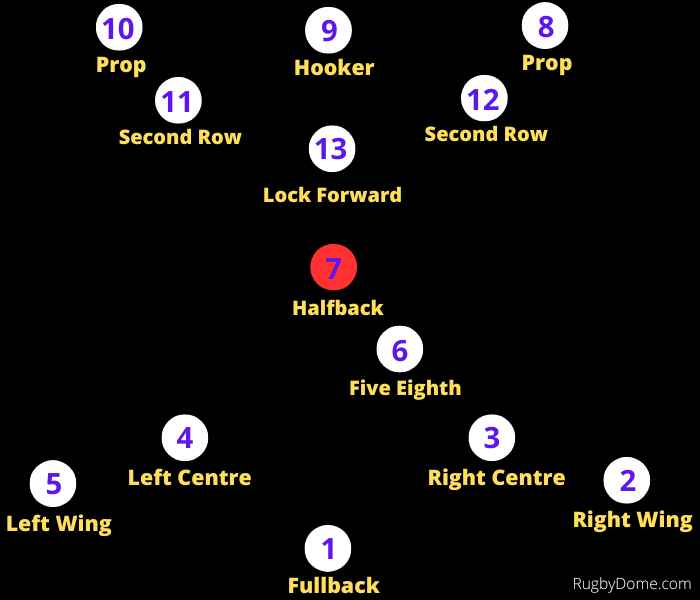The halfback is also known as the scrum half or just the half in rugby league. There is one halfback on a league team and they traditionally wear the number seven jersey.
The halfback is the primary playmaker in the team. In other words, they initiate and direct the attack.
This article looks at the crucial role of rugby league halfbacks in league.
We have a separate article about the role of the scrum half in rugby union and in sevens.
Why Are They Called Halfbacks?
The name comes from the early history of the sport before it split into rugby league and rugby union (the 15-player version of the sport).
In the early 19th century days, there were only two specialist positions: everybody was either a forward or a back.
As the sport evolved, the backs split into two types. The ones who were furthest away from the scrum were the “full” backs.
A few players stood nearer to the pack of forwards. These were the “half” backs.
In modern rugby league, the number in the team has been reduced to one halfback.
Positioning
Although scrums aren’t as important in rugby league nowadays, it’s still helpful to show where the halfback stands in relation to the other players.
This picture shows their position during a scrum.

What Do Halfbacks Do In Attack?
As the primary playmaker, the halfback organizes the attacking play.
When the ball carrier is tackled and executes the play-the-ball, the dummy half (often the hooker) picks up the ball and usually passes it to the halfback.
At this point, the halfback either runs, passes, or kicks the ball. Their decisions define how the play unfolds.
When they pass to a teammate, they track the ball carrier to provide support and more attacking opportunities. This also makes them available to receive the ball again from the dummy half.
Their key role in distributing the ball means that halfbacks must have excellent ball-handling skills. They must be able to execute short and long passes off both hands.
Halfbacks are usually the main kickers on their team. They execute the bombs and cross-field kicks.
Because of their key role, halfbacks are usually targeted by the opposition. Defenders try to close down their space and their options. That means that halfbacks must learn to make fast decisions under pressure.
Working With Their Five-Eighth
The relationship of the halfback with the five-eighth in league is crucial for the team’s attacking play.
The halfback and five-eighth (also called the standoff) share the playmaking responsibilities. The halfback is more of an organizer, while the five-eighth is often the next player who receives the ball.
The halfback is less likely to run hard into contact, while the five eighth gets more involved in direct running. The two are constantly communicating throughout a game.
Role Of Halfbacks In Defence
Because of their vital role as playmakers, the rest of the team try to keep their halfback from making a lot of tackles. But they still need to tackle players who come into their zone.
As halfbacks must have good pace, they are also involved in covering their teammates. That includes tracking back to support the fullback or moving swiftly across the field to help a winger.
Famous Halfbacks In League History
Here are two famous halfbacks from two different countries.
Andrew Johns
Andrew Johns made his name as one of the great players with the Newcastle Knights. He was nineteen on his professional debut off the bench.
The following year, he became the starting halfback. His older brother was five eighth, and the Johns brothers were hugely effective.
Johns switched between halfback and hooker. He was the hooker and player of the tournament when Australia one the World Cup in 1995. But he was halfback when guiding the Knights to their first ARL title in 1997.
Johns assumed the captaincy of both his club and country. Despite being beset by injuries at times, he was a leader on the field whose quick thinking and deft skills steered his teams to victory.
Shaun Edwards
Shaun Edwards made his professional debut for Wigan, the giant English club, when he was seventeen. He played halfback in their win.
Edwards moved between halfback, five eighth, and fullback. He was known in a tough sport for being as hard as nails. He was the English league’s top try scorer in his 1991/92 season.
He was also Great Britain’s youngest international when he played against France in 1985. Ten years later, he captained England in the 1995 World Cup.
Since retiring from league, Edwards has become an outstanding defensive coach in rugby union.